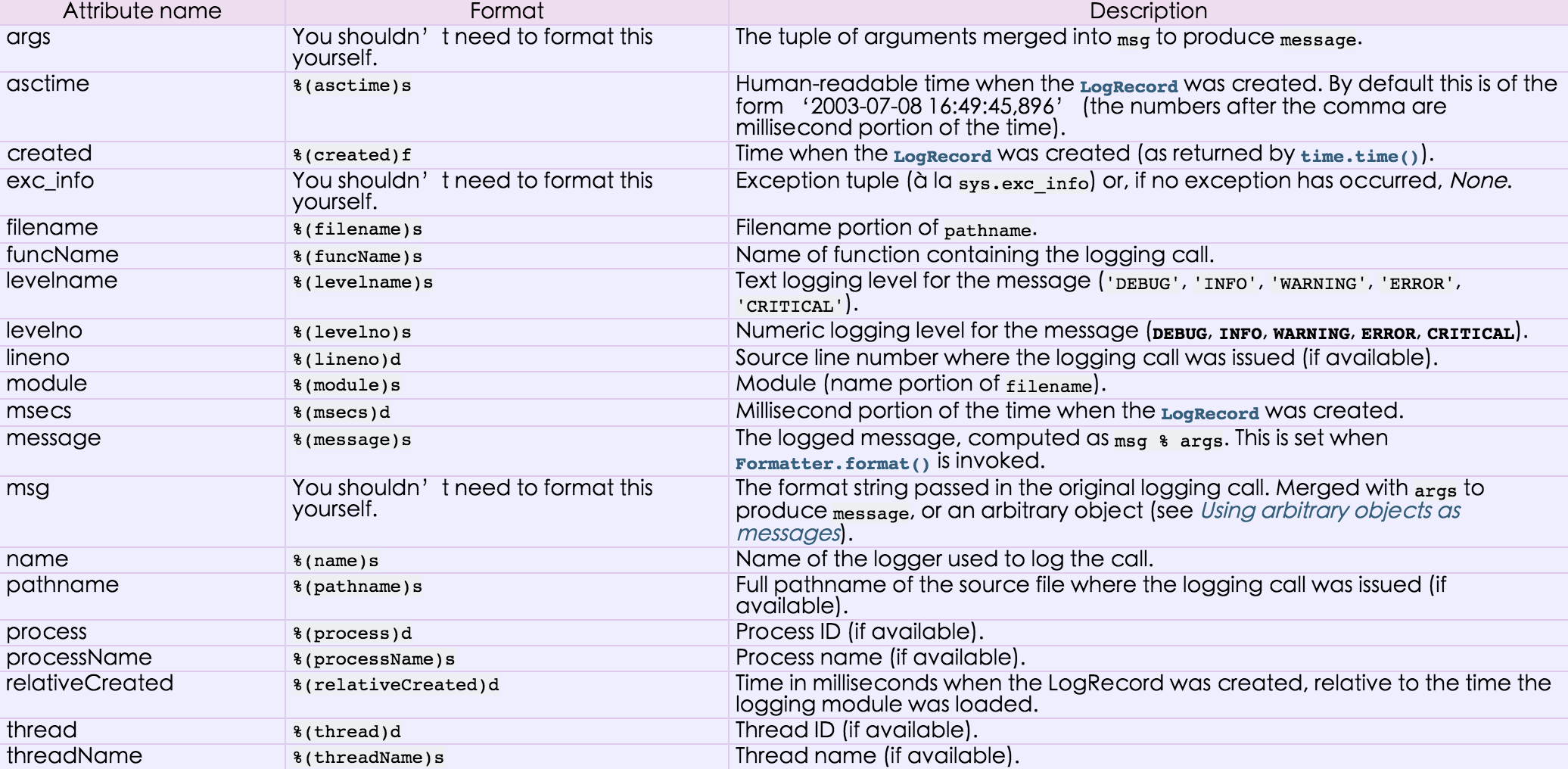Python学习笔记——基础篇【第六周】——logging模块
常用模块之logging
用于便捷记录日志且线程安全的模块
import logging
logging.basicConfig(filename='log.log',
format='%(asctime)s - %(name)s - %(levelname)s -%(module)s: %(message)s',
datefmt='%Y-%m-%d %H:%M:%S %p',
level=10)
logging.debug('debug')
logging.info('info')
logging.warning('warning')
logging.error('error')
logging.critical('critical')
logging.log(10,'log')
对于等级:
CRITICAL = 50 FATAL = CRITICAL ERROR = 40 WARNING = 30 WARN = WARNING INFO = 20 DEBUG = 10 NOTSET = 0
只有大于当前日志等级的操作才会被记录。
对于格式,有如下属性可是配置:

---------------------------------------------------------------------------------------------
很多程序都有记录日志的需求,并且日志中包含的信息即有正常的程序访问日志,还可能有错误、警告等信息输出,python的logging模块提供了标准的日志接口,你可以通过它存储各种格式的日志,logging的日志可以分为 debug(), info(), warning(), error() and critical() 5个级别,下面我们看一下怎么用。
最简单用法
import logging
logging.warning("user [alex] attempted wrong password more than 3 times")
logging.critical("server is down")
#输出
WARNING:root:user [alex] attempted wrong password more than 3 times
CRITICAL:root:server is down
看一下这几个日志级别分别代表什么意思
| Level | When it’s used |
|---|---|
DEBUG |
Detailed information, typically of interest only when diagnosing problems. |
INFO |
Confirmation that things are working as expected. |
WARNING |
An indication that something unexpected happened, or indicative of some problem in the near future (e.g. ‘disk space low’). The software is still working as expected. |
ERROR |
Due to a more serious problem, the software has not been able to perform some function. |
CRITICAL |
A serious error, indicating that the program itself may be unable to continue running. |
如果想把日志写到文件里,也很简单
import logging
logging.basicConfig(filename='example.log',level=logging.INFO)
logging.debug('This message should go to the log file')
logging.info('So should this')
logging.warning('And this, too')
其中下面这句中的level=loggin.INFO意思是,把日志纪录级别设置为INFO,也就是说,只有比日志是INFO或比INFO级别更高的日志 才会被纪录到文件里,在这个例子, 第一条日志是不会被纪录的,如果希望纪录debug的日志,那把日志级别改成DEBUG就行了。
logging.basicConfig(filename='example.log',level=logging.INFO)
感觉上面的日志格式忘记加上时间啦,日志不知道时间怎么行呢,下面就来加上!
import logging
logging.basicConfig(format='%(asctime)s %(message)s', datefmt='%m/%d/%Y %I:%M:%S %p')
logging.warning('is when this event was logged.')
#输出
12/12/2010 11:46:36 AM is when this event was logged.
如果想同时把log打印在屏幕和文件日志里,就需要了解一点复杂的知识 了
The logging library takes a modular approach and offers several categories of components: loggers, handlers, filters, and formatters.
- Loggers expose the interface that application code directly uses.
- Handlers send the log records (created by loggers) to the appropriate destination.
- Filters provide a finer grained facility for determining which log records to output.
- Formatters specify the layout of log records in the final output.
import logging
#create logger
logger = logging.getLogger('TEST-LOG')
logger.setLevel(logging.DEBUG)
# create console handler and set level to debug
ch = logging.StreamHandler()
ch.setLevel(logging.DEBUG)
# create file handler and set level to warning
fh = logging.FileHandler("access.log")
fh.setLevel(logging.WARNING)
# create formatter
formatter = logging.Formatter('%(asctime)s - %(name)s - %(levelname)s - %(message)s')
# add formatter to ch and fh
ch.setFormatter(formatter)
fh.setFormatter(formatter)
# add ch and fh to logger
logger.addHandler(ch)
logger.addHandler(fh)
# 'application' code
logger.debug('debug message')
logger.info('info message')
logger.warn('warn message')
logger.error('error message')
logger.critical('critical message')
参考链接:
http://www.cnblogs.com/alex3714/articles/5161349.html
http://www.cnblogs.com/wupeiqi/articles/4963027.html



 浙公网安备 33010602011771号
浙公网安备 33010602011771号